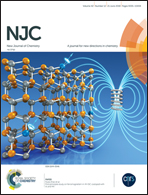Hydrazinopyrimidine derived novel Al3+ chemosensor: molecular logic gate and biological applications†
Abstract
Cost-effective and highly sensitive biocompatible probes for the detection of Al3+ have tremendously important practical applications. Herein, we report for the first time, the hydrazinopyrimidine based Al3+ chemosensor L (1-[(4,6-dimethyl-pyrimidin-2-yl)-hydrazonomethyl]-naphthalen-2-ol) prepared by the condensation of 2-hydroxy-1-naphthaldehyde and 4,6-dimethyl-2-hydrazino-pyrimidine. Our as-synthesized chemosensor L (Φ = 0.0066) shows ∼15 fold fluorescence enhancement in the presence of Al3+ (Φ = 0.0955, Ka = 1.9 × 104 M−1) via chelation enhanced fluorescence (CHEF), excited state intramolecular proton transfer (ESIPT), and inhibited photo-induced electron transfer (PET) phenomena. The limit of detection (LOD) and limit of quantification (LOQ) were estimated to be 2.78 μM and 9.27 μM, respectively. Furthermore, for the first time, a hydrazino pyrimidine based ‘INHIBIT’ molecular logic gate for Al3+ was successfully developed using the fluorescence properties of L. The experimental sensing mechanisms of L for Al3+ were corroborated by theoretical calculations. Biocompatibility and good water-solubility properties of a pyrimidine moiety of L inspired us to investigate Al3+ imaging in human embryonic kidney cell lines, HEK293, and the results for practical applications are highly promising.



 Please wait while we load your content...
Please wait while we load your content...